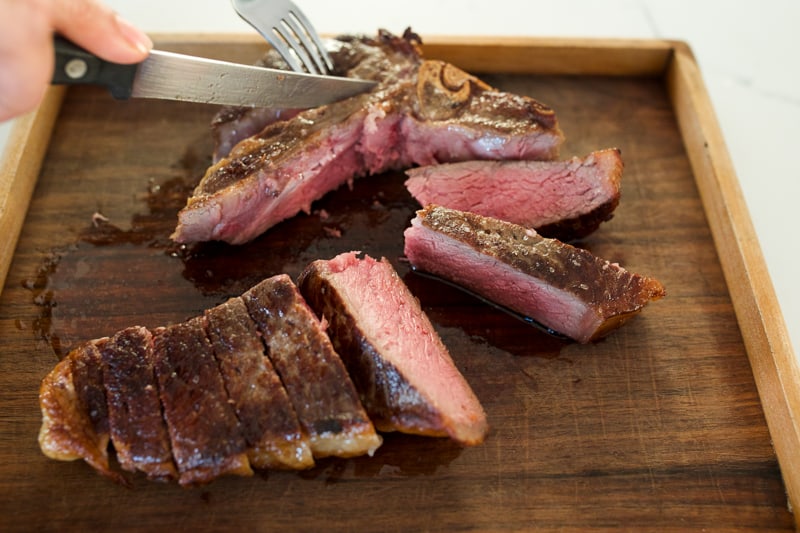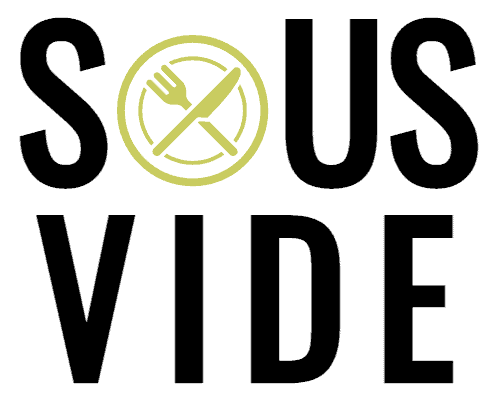It’s true. Medium rare steak temp is perfect.
A medium rare steak is cooked to an internal temperature of 135°F. As a result, the steak has a seared exterior and a juicy and warm red center. And it’s not just a personal preference that deems medium rare the best temperature and doneness for steak—it’s science.
In culinary school, much of the curriculum focuses on the science behind cooking. For me, that meant studying the chemical reactions that make a great steak. I firmly believe that once you master a few scientific principles, you can cook anything.
In this article, I’ll explain what happens when heat meets steak protein. We’ll unpack the science that explains why, at 135°F, you’ll get the perfect steak. And I’ll share a few tips to help you make the perfect steak at home, every time.
If you really just care for the steak temps, here you go:
Table of Contents
Steak Temperature Chart – Fahrenheit & Celsius
| Target Doneness | Temperature Range | Est. Cook Time at 450°F / 232°C (Minutes per Side) |
| Very Rare to Rare + | 125°F (52°C) | 120°F (49°C) to 129°F (54°C) | 2:30 |
| Medium Rare | 135°F (57°C) | 130°F (54°C) to 137°F (58°C) | 3:30 |
| Medium | 140°F (60°C) | 138°F (59°C) to 144°F (62°C) | 4:30 |
| Medium Well | 150°F (65°C) | 145°F (63°C) to 155°F (68°C) | 5:30 |
| Well Done | 165°F (74°C) | 156°F (69°C) + | 6:30 |

Steak Temperature Doneness
Expert Tip: Keep in mind if you’re grilling, pan searing, or broiling your steak, remove the steak from the heat source when you’re 5 degrees Fahrenheit from your target temperature. The steak will continue to rise in temperature after being removed from the heat source.
Rare (125°F)
A rare steak is the least amount of doneness that you could order.
People enjoy steak at this temperature because it’s tender, moist, and never dry or chewy. To the touch, the meat is incredibly soft and yielding. If you press on it, the impression of your finger will last.
Oh, and the red juice in a rare steak isn’t actually blood. It’s myoglobin. That’s what adds a burst of flavor to each bite.
A rare steak is cooked to an internal temperature that ranges from 120°F to 129°F. It’ll have a brown, charred exterior and a cool to just-warm bright red center. Often, it’ll look like raw meat with a sear on the outside.
It’s safe to eat a rare piece of steak because pathogens can’t permeate through the exterior of the meat; they’ll only sit on the outside. The initial sear on the steak will be hot enough to kill these pathogens, so you’ll be left with a perfectly safe bite. Plus, you’ll receive a jolt of iron and phosphorus right to the system, which will help prevent fatigue and strengthen your bones (the more you know!).
If you’re looking for an extreme rare, read The Safe Way to Cook Blue Rare Steak (+ Health Benefits).
Medium Rare (135°F)
A medium rare steak cooked to 135°F will have a seared, slightly charred exterior and a warm, bright red center. Remember to pull the steak at 130°F to achieve 135°F.
It’ll have a firm surface that gets softer as you move to the thickest part of the steak, the center. But even the squishiest part will spring back quickly after you touch it. It’ll maintain the tender juiciness we want but has more flavor development than a rare steak.
Medium rare is the perfect doneness because of the flavor window created at its internal temperature. Buckle in; here’s a brief and easy science lesson.
Meat includes proteins—Myosin and Actin—which are responsible for muscle contraction. If you flex a muscle, you can feel its rigidity and stiffness. So, you can guess how these proteins will affect your steak.
Ideally, we all want that delicious, tender, melt-in-your-mouth bite. The key to achieving this is cooking your steak to just the perfect temperature. We want these proteins to break down just enough. This way, the meat will have more structure than a slippery, rare bite and less stiffness than a leathery, well done texture.
Expert Tip: Across the board, most people prefer their steak with more Actin than Myosin. This window of opportunity in the cooking process happens at exactly 135°F. Plus, 135°F isn’t hot enough to evaporate all those wonderful and tasty juices.
Okay, the science lesson is over. But hey, now you can justify precisely why a medium rare steak is proven to be the tastiest temp.
Medium (140°F)
A medium steak will have more dark brown meat than a rare or medium-rare steak. The brown meat will start creeping into the center, not just remain on the very edges. There will be a thick pink band through the middle, and it’ll have a pretty firm consistency throughout the whole cut, with just a slightly softer center.
A medium steak ranges from 138°F to 144°F and is usually a great bet when cooking for a bunch of people. It’s an excellent middle-of-the-road doneness that’ll please just about everyone. It’s not too tough, still full of flavor, and it’s cooked enough to keep everyone happy.
Medium Well (150°F)
A medium well steak ranges from 145°F to 155°F and will be completely firm throughout to the touch. It’ll be almost entirely brown from the surface sear to the slightest hint of a pink hue in the very center. The proteins constrict exponentially at this temperature, so expect the meat to be tougher and chewier.
There won’t be any red juices spilling from this steak. And if you want to cook a medium-well steak, you should begin with a very soft, tender cut so that the result isn’t leathery.
Well Done (165°F)
Sous vide cooking is the only way to achieve a well done steak that isn’t too tough or dry to chew. This is because you’ll be able to cook the meat low and slow. With sous vide, you can cook it to a brown color throughout without burning the exterior on a grill or in the oven.
Well done steak has an internal temperature that falls between 156°F and 170°F. There will be no pink whatsoever in the meat. In addition, it’ll have a brown color from the exterior all the way through to the very center. The meat will feel rigid, unyielding, and solid to the touch.
Expert Tip: It’s important to let all steaks rest once they come off the heat so that the muscle fibers can relax, but this is especially true with a well done steak.
When the muscle fibers contract and toughen up during cooking, all the meat’s moisture is pushed to the surface. And when you cut into it, they’ll be released.
Allow your well done steak to rest before cutting into it. This will ensure that the juices can redistribute. You’ll want to maintain as much of them as possible to keep your well done steak as tender as possible.
Factors that Affect Steak Doneness
Thickness of Steak
Depending on how thick or how thin your steak is will affect how long you need to expose it to heat to achieve the desired amount of doneness.
A thin steak will cook through quickly. It’s usually cooked over higher heat to effectively sear the outside without overcooking the center.
Thicker steaks, on the other hand, require a more low and slow approach so that the outside doesn’t burn before the center can come to temperature.
Fat Content
Fattiness insulates the meat and keeps it juicy for longer, so you can cook a fattier cut for longer on a lower heat than you would a lean cut.
Bone-In vs. Bone-Out
Bone-in vs. bone-out also plays a role. Bones take longer to heat up than the beef around them, and they’ll hold onto that heat for longer. It’ll take longer to cook a bone-in steak to ensure that the meat around it reaches temperature.
Cooking Method
Your chosen cooking method will drastically affect how you achieve your desired doneness. For example, trying to nail your exact goal temperature using a grill or range is much more challenging than using the sous vide method.
With sous vide, you can accurately calculate and monitor the steak’s internal temperature so that it comes out precise and even every time. Anyone can cook a perfect steak with the sous vide method; no fancy professional skills are needed, but the result will taste gourmet. In fact, top chef’s like Thomas Keller use sous vide in their restaurants.
Starting Temperature
A cold steak will take much longer to reach the appropriate temperature than a room-temp one. When you start with a cold steak, it’s easy to overcook the meat’s exterior since it’ll warm up the fastest and be exposed to the heat the longest.
Expert Tip: Allow your steak to come to room temperature for the best results and the most accurate and consistent temperature before cooking it!
Determining Your Steak Doneness
Meat Thermometer
When in doubt, you can always use a meat thermometer to gauge the doneness of your steak accurately. Follow the internal temperatures outlined earlier in this article, and you can tell how far along your meat is.
When using a meat thermometer, remember to take the temperature from the middle of the thickest part of the steak. If you’re cooking a bone-in steak, check the temperature by the bone.
Other Methods
There are countless methods other than a meat thermometer to determine the doneness of your steak, but they’re not always accurate.
Some people cut into the steak to check the inside, but you’ll lose all those precious juices if you do this. Truthfully, it’s not great for presentation, either. You can use one of those point-and-shoot surface thermometers, but it won’t give you the most accurate internal temperature.
Steak Finger Test / Palm Method
In culinary school, we were taught a trick to measure the doneness of a steak by touch. First, open your hand, and relax it. Then, poke the fleshy part of your palm under your thumb. It’ll feel soft and giving, just like a raw steak.
Now, connect your thumb and index fingertips, giving that same under-thumb area a feel. That tighter yet still-yielding feel mimics a rare steak. You’ll understand what a medium-rare steak would feel like when you touch your thumb to your middle finger and do the same process.
Touching your thumb to your ring finger will feel like a medium steak, and to your pinky for a medium well result. A well done steak won’t have much give at all.
Is Medium Rare the Perfect Doneness?
Expert Tip: Medium-rare is hands-down the best way to cook your steak. Its internal temperature of 135°F lands the meat in the perfect window for the ultimate texture and flavor.
It’s not hot enough for all the moisture in the meat to evaporate at 135°F, so you’ll be able to enjoy juicy bite after juicy bite. Plus, there’s more Actin protein than Myosin, resulting in a tender, melt-in-your-mouth texture. Seriously, you won’t be able to help the yum that escapes after trying a slice.
The best news is that the easiest way to ensure you hit that ultimate medium rare temperature is to use the sous vide cooking method. With this cooking method, you can calculate the exact amount of cooking time you’ll need to reach medium rare, so there isn’t any guesswork involved.
You won’t need to poke the meat with a thermometer or prod it with your finger. And you definitely won’t need to cut into it to take just a little peek at the center (we’ve all been there.)
Are There Exceptions to the 135°F Rule
Yes, there are some exceptions, but those exceptions live firmly within the 130-137°F window for medium rare doneness. The exceptions center around fat content and to some degree personal preference.
For instance, for a filet mignon, given it is a very lean cut of steak, a target temperature closer to 130°F will retain more moisture and is how I prefer filet mignon. For something more buttery like a ribeye, there is a whole camp who scream 137°F is the ideal temperature because of how the fat renders at that temperature.
So, what are you waiting for? Hit the grocery store and buy that cut of filet mignon or ribeye you’ve been eyeing (you deserve it). Then, follow the step-by-step walkthrough on how to sous vide the most perfect steak you’ve ever tasted.
USDA Steak Temperature Recommendation
The USDA recommends steak be cooked to an internal temperature of at least 145°F.
Cooking Steaks FAQs
The ideal medium-rare steak temperature is 135 degrees. The window for medium-rare steak doneness is 130-137 degrees.
135 degrees is the ideal internal temperature for medium-rare steak. 130-137 degrees is the window for medium-rare steak doneness.
No, 145 degrees internal temp is not medium-rare for a steak; It is medium, not medium-rare.
To cook a steak medium-rare target 3:30 minutes per side at 450 degrees. This is general guidance for a steak 1-1.25″ thick. Use a meat thermometer to determine when 130 degrees is reached and then let rest for 10 minutes. If you don’t have a meat thermometer, relax your hand and touch your thumb to your middle finger and feel the meaty part of your palm under your thumb. This is what a medium-rare steak should feel like to the touch.
A 145 degrees steak is borderline medium and medium-well.

